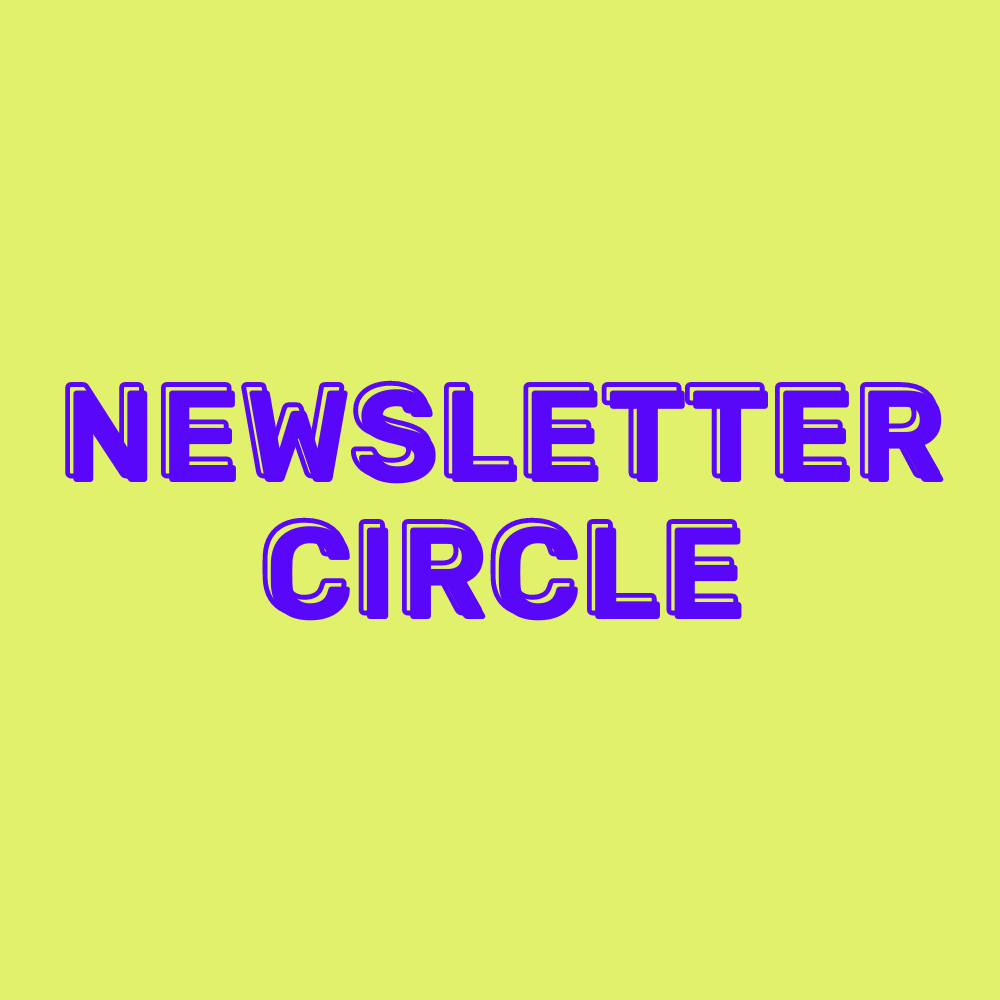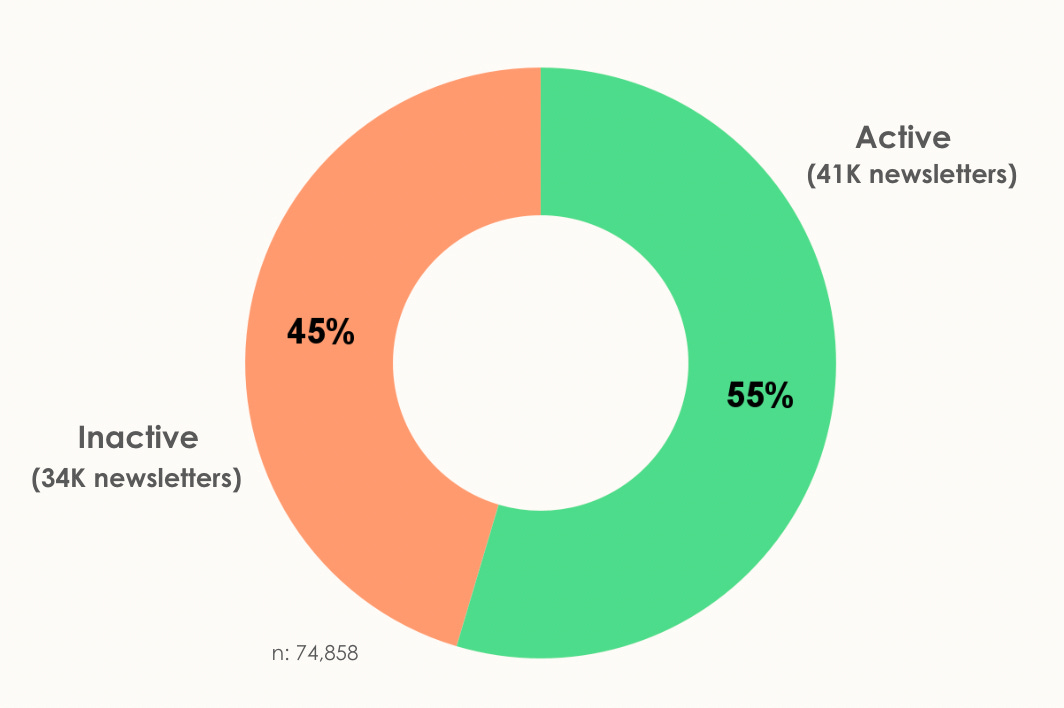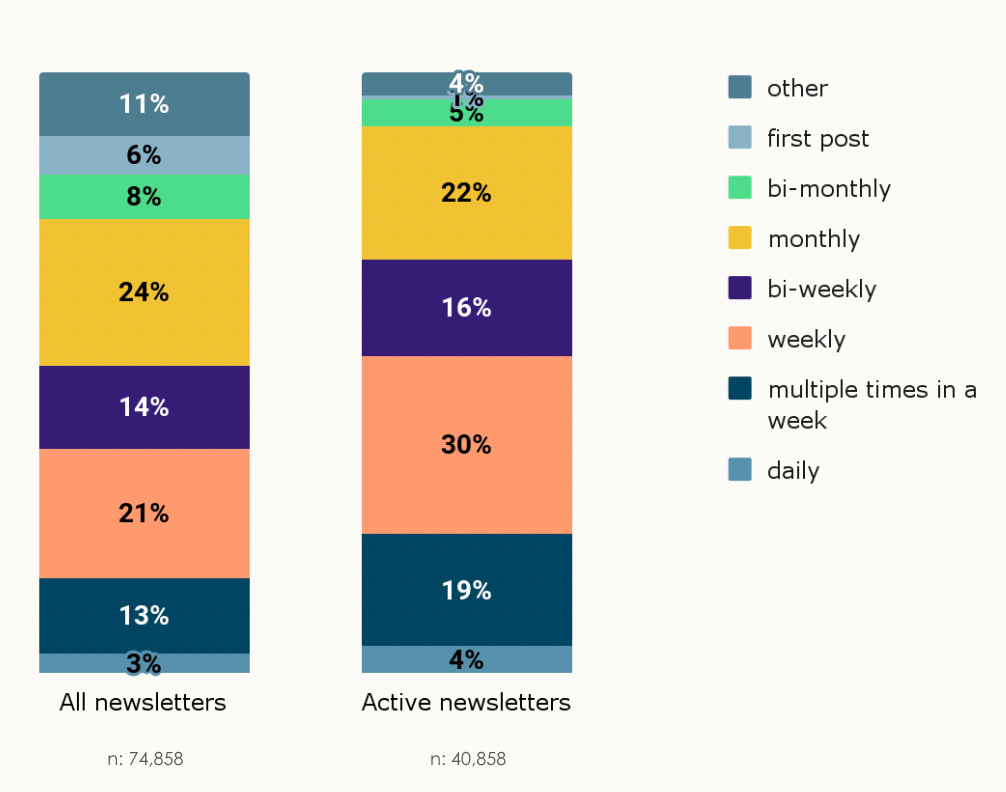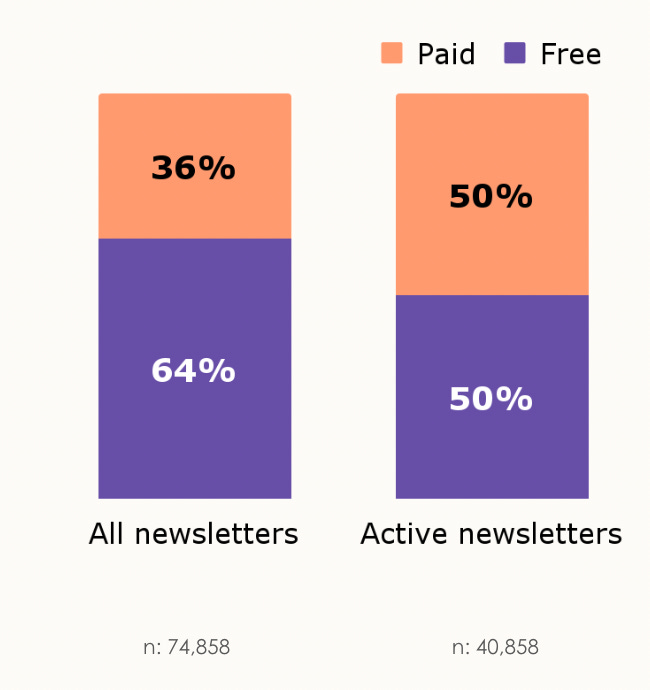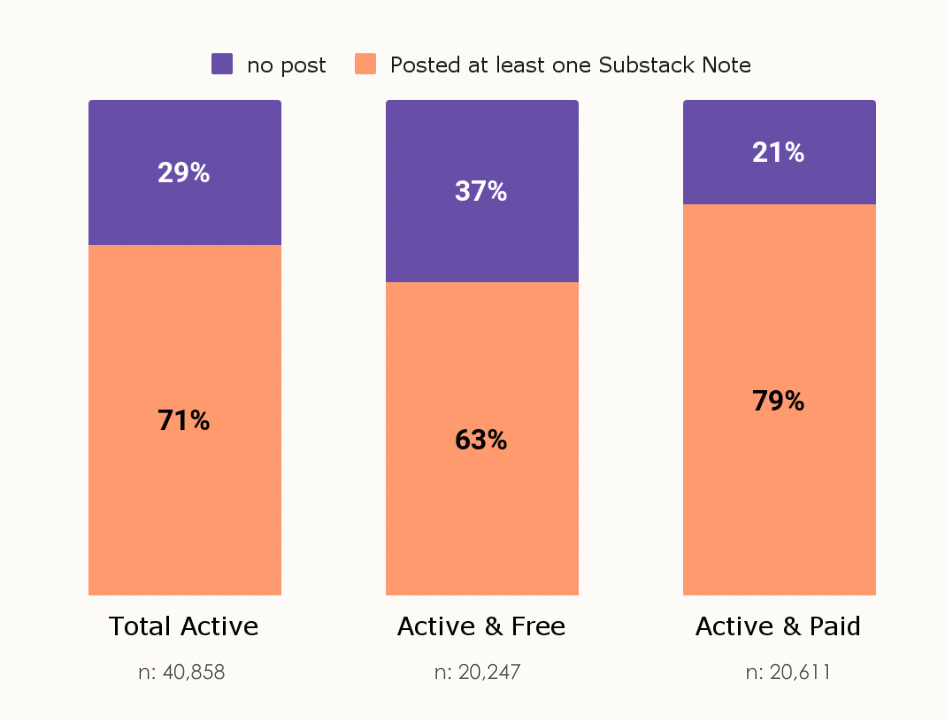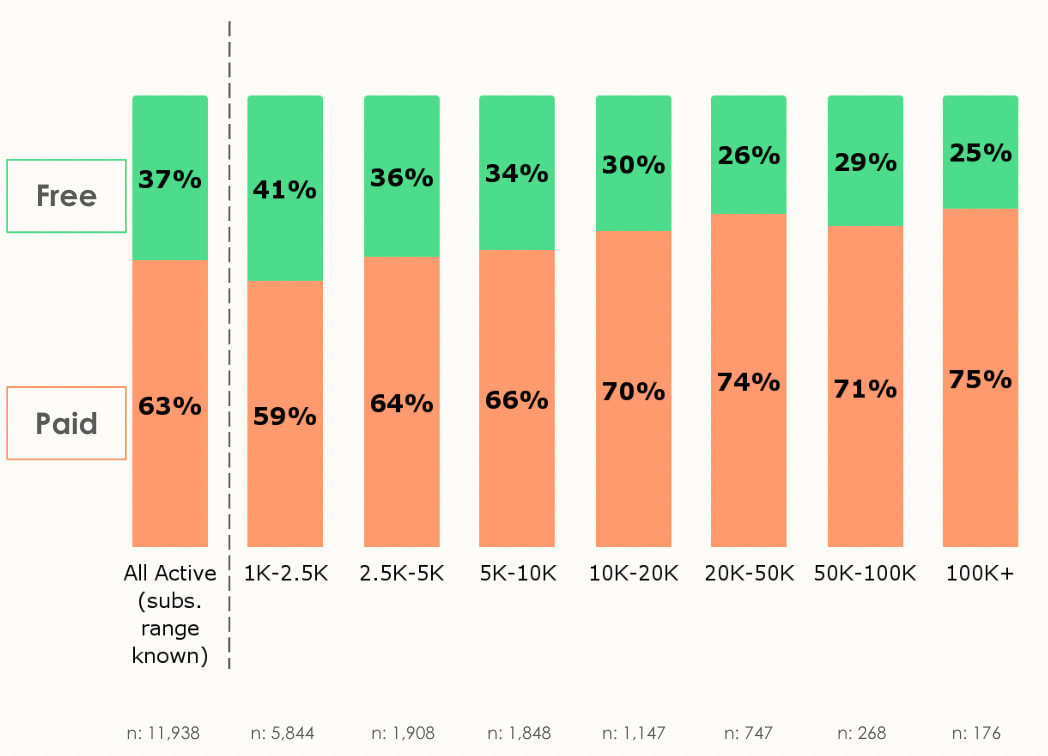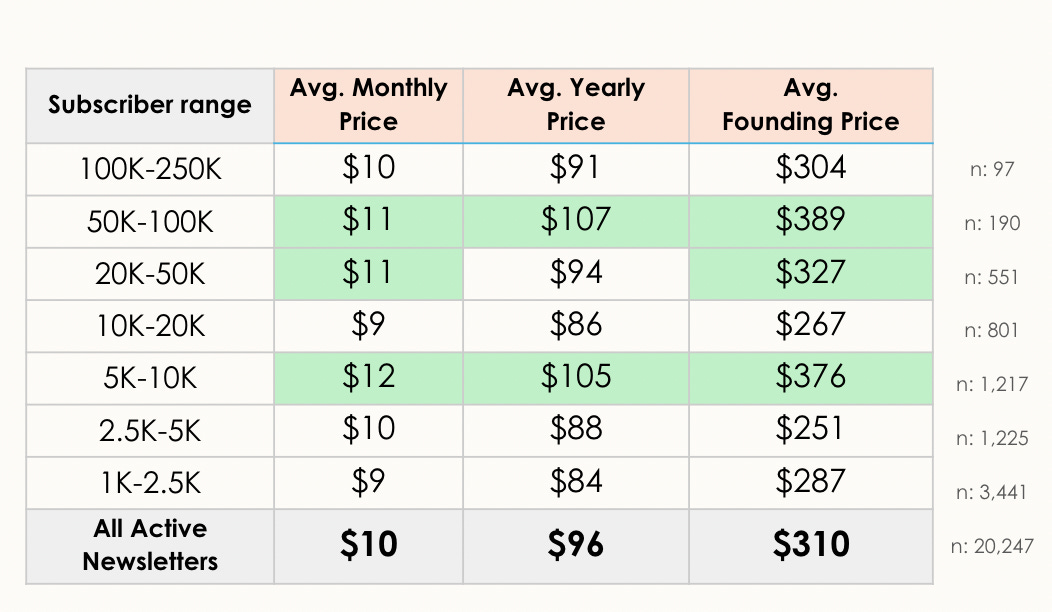Why 45% of Substacks go inactive, and other findings from combing through 75k newsletters
Uncover the surprising patterns behind newsletter longevity, creator challenges, and the strategies that separate thriving publications from the rest.
Hi,
I’ve been reading
’s Newsletter Circle since long before they featured me in an issue. When I saw they released a massive study analyzing the habits of 75,000+ Substack publication, I took the opportunity to ask them some questions about what they learned through the process.If you haven’t checked it out yet, then it’s a great publication that just recently moved back to Substack.
Tell us about yourself and the idea behind this report.
Hi everyone! This is Ciler. I’m the founder of Newsletter Circle, which is a go-to source content platform for newsletter operators. I started Newsletter Circle by doing in-depth written interviews with successful newsletter operators about how they built their newsletter businesses from scratch.
After interviewing over 60 operators and studying their individual newsletters, I saw a need to see the bigger picture of the newsletter landscape. I’ve never seen a large scale analysis of newsletters. So, I decided to get my hands dirty and analyzed 75K Substack newsletters. The report gives answers to questions such as:
How many newsletters are active and inactive?
How frequently do creators publish new issues?
What are the subscriber ranges?
What is the usage rate of Substack Notes and Substack Recommendations?
How many newsletters offer a paid subscription?
What are the average paid subscription prices?
What are the social media channels most preferred by different categories?
Can you give us some insight about the data set you used.
As you might guess, I didn’t gather this data manually, which would take months. Instead, I scraped publicly available data of 75K Substack newsletters. All the information you see can be found on the included newsletters’ pages. Data scraping requires technical expertise so I worked with an expert in this area. We scraped the maximum number of newsletters that we could.
I also worked with an experienced data analyst to clean the data, verify its accuracy, and perform some statistical calculations.
I then spent several weeks analyzing the raw data, uncovering insightful findings, and crafting the report. I have a solid background in market research that also helped me a lot along the way.
From a technical perspective, Substack’s platform allowed for easier data gathering, which is why I started with it. However, I’m exploring ways to create similar reports for Beehiiv and Kit newsletters in the future.
Your analysis shows that 45% of all newsletters are inactive tracks with my own colloquial data. Why do you think that almost half of all newsletters on the platform are defunct?
As you said, 45% of newsletters are inactive—equivalent to 34K inactive newsletters.
This is massive!
As newsletter creators, we know how easy it is to start but this shows how challenging it is to keep going. Most people launch newsletters with great intentions, but few stick with it because:
It requires patience: Consistency is key, even when results aren’t immediate.
It requires resilience: Emotional highs and lows are part of the journey, and you have to push through them.
It requires self-discipline: According to the report, 95% of newsletters are solo ventures. Without a team, staying motivated falls entirely on you.
It’s a momentum work. Once you lose that momentum, it’s inevitable to give up altogether.
It’s also a long-term game. Building a sustainable newsletter takes time—especially when it comes to monetization. Creators who start with unrealistic expectations of rapid growth and high revenue often lose motivation, which contributes to the high number of inactive newsletters.
For me, seeing these struggles reflected in real data was both eye-opening and validating. That’s why so many newsletter creators I’ve interviewed on Newsletter Circle emphasize the same advice: “Don’t give up. Keep going.”
It might sound like a cliché, but the data proves just how crucial this mindset is.
What are the top characteristics that separate successful, active Substack newsletters from defunct, inactive ones?
We said 45% of newsletters are inactive. But, if you read this data from a positive angle, it says something highly encouraging to newsletter operators:
“If you publish your newsletter consistently, you’re already ahead of nearly half the creators out there!”
In addition to being consistent, active newsletters publish more frequently compared to the overall average. Among actives, publishing multiple times a week is 19% (vs. 13% in total) and weekly publishing is 30% (vs. 20% in total).
Another finding is that the percentage of active newsletters increases as subscriber numbers grow. The highest percentage is observed among newsletters that have 100–250K subscribers (81%).
Another finding is that the more active newsletters are, the higher the paid subscription ratio is. Among 41K active newsletters, 50% offer a paid subscription, compared to just 36% across all 75K newsletters.
This suggests that creators who position their newsletters as businesses with bigger lists are more likely to stay in the game.
As an additional personal comment, I think it’s also critical to be clear about how to position a newsletter and set expectations accordingly. If it’s a hobby project, then not seeing a huge growth shouldn’t be a problem. If it’s a business project, then creators should approach their newsletters as a product and make concrete business plans. Otherwise, they are disappointed and give up more easily.
For curious readers, here are a bit more detailed definitions for active and inactive newsletters in this report.
Data for the report is pulled on May 10th. Newsletters that published their latest issue within the past six weeks (between April 1st and May 10th) are classified as “Active.” On the other hand, newsletters that published their latest issue more than six weeks ago (before April 1st) are classified as “ Inactive.”
The report mentions untapped potential in active newsletters that don’t use Substack’s Recommendation and Notes features. What do you mean by that?
It was surprising to see that 22% of active newsletters don’t use Substack Recommendations. To me, Substack Recommendations is a no-brainer. I’m not sure why some creators choose not to leverage it, as the report doesn’t provide answers to this question.
As for Notes, I didn’t find anything specific in the data. However, based on my previous conversations with creators, I can share a few comments about Substack Notes:
Limited awareness: While Substack Notes is becoming more popular, some creators might not yet realize its potential for growth and engagement. That’s why I aim to highlight its use in my creator interviews.
Lack of time: Creators who grow with Substack Notes are highly consistent, publishing multiple Notes daily. But focusing on multiple distribution channels isn’t easy. Creators already active on LinkedIn, X, or other platforms might struggle to make time for Substack Notes.
Lack of target audience: For some creators, Substack Notes might not align well with their newsletter’s target audience, leading them to prioritize other channels.
Only 36% of newsletters analyzed have a paid option, and yet paid newsletters seem to have considerably more engagement than free ones. Should more newsletters think about going paid to boost engagement, or do you think those with the most engagement tend to go paid?
I think both approaches are valid.
From the data, we see that as the number of subscribers increases, the paid subscription ratio also rises. This suggests that many creators prefer to wait until they’ve reached a certain list size before activating paid subscriptions. They want to ensure that the conversion rate will justify the effort required to produce premium content.
Additionally, the data shows that paid newsletters tend to publish more frequently than free ones, which naturally leads to higher engagement rates.
On the other hand, based on my interviews with newsletter creators, I’ve observed a growing trend of creators offering paid subscriptions even with smaller lists.
These creators often maintain close relationships with their subscribers, regularly gathering feedback to understand their audience’s needs. This helps them feel confident about converting their superfans into paying subscribers right from the start—and they often succeed. So, for smaller newsletters, fostering engagement before going paid is highly crucial.
Among the 20k active publications that offer paid subscriptions, the average price was $10/mo and $96/yr. Most newer newsletters prefer to fall way below that, with many wanting to price below the $5/mo that Substack allows as the lowest price. How should we use this report to influence our own paid journey?
The data confirms that the average price is not $5 or below. It’s $10 and doesn’t vary much for different subscriber ranges.
The paid subscription price depends on how unique your content is, how much value you provide to your paid members and the level of trust you build before going paid. Despite the fact that there is no one-size-fits-all answer to your question, I think there are two approaches:
Start with a low price and increase gradually until finding that sweet spot where you maximize conversion.
Start with a higher price, observe conversions, gather feedback from super fans who don’t convert and lower the pricing accordingly if this is the issue. Maybe you’ll find out it’s your content, not about the price.
There is still a lot to explore about paid subscriptions, so in 2025, I’ll create exclusive content about paid subscription best practices for my paid members.
English dominates the Substack landscape. How can creators working in less common languages break through and build sizable audiences?
First, I would recommend creators conduct some online market research to determine whether there is interest in their newsletter topic within that specific language or region. They can check certain keywords on Google Trends, use tools such as Semrush and search forums.
Next, they should craft a strategy tailored to the content consumption habits of the audience in that language. They shouldn’t rely on in-platform discovery mechanisms like Recommendations or Notes since they’re also dominated by English content.
For example, if the audience prefers reading blogs, creators can start by building a blog, driving traffic, and capturing email addresses through their website. Alternatively, if the audience is more active on social media, creators can focus on building their following on relevant platforms and then direct those followers to their newsletters.
Certain categories in your analysis (e.g. food publications) show distinct social media preferences (e.g. Instagram and TikTok). How should creators tailor their content strategy based on niche-specific trends highlighted in the report?
It’s all about knowing your audience, where you can find them, and finding the best platform for your content. For a business newsletter, it might make more sense to hang out on LinkedIn, whereas an art newsletter reaches out to a wider audience on Instagram.
For example, 15% of food newsletters share their TikTok accounts, compared to only 6% of all links shared are Tiktok links. They probably share recipes and food videos more easily on this platform.
So, I recommend gathering subscriber information and conducting market research to clarify the newsletter positioning and craft a growth strategy accordingly. A few quick recommendations are:
Make a sign-up survey and ask their social media accounts to your subscribers
List your competition and research where they’re actively publishing content continuously other than their newsletters.
Explore what type of content on those relevant channels gets more engagement.
Each social media channel has its own dynamics to be successful. Study ways to increase the number of followers on those channels.
Repurpose your newsletter content on the channels you choose continuously.
I’ve followed your newsletter for a long time, and love how you run your publication. Is there anything you found in this Substack specific analysis that you’ll be bringing into how you run your own publication outside of it?
Here are my three major decisions after the report:
This report is a product of asking questions that haven’t been asked before and doing dedicated research to reach unique insights. In 2025, I’ll focus more on creating such original content with a “ content journalist” mindset. As newsletter creators, we need more original content supported by real data, and I love doing it.
I initially started Newsletter Circle on Substack but switched to Beehiiv for better user analytics. However, to promote the report, I began publishing it on Substack Notes and collaborating with Substackers (like this interview:)), which showed me how impactful Substack is for engagement. I need a platform that prioritizes engagement, so I’m back to Substack.
I recently launched a paid subscription to Newsletter Circle.
The report provides a snapshot of the current data, but I want to explore paid subscriptions further because I have many questions.
With that in mind, I’ll be publishing mini-reports and more dedicated content about "paid subscription best practices" for my paid members.
I’ll start researching Substack bestsellers with Purple, Orange and White badges. I have already identified 4,000 Substack bestsellers with these badges, and I will analyze them one by one. Here is the list of 47 Substack newsletters with purple badges:
Where can we find more about your work and how can they download this report for themselves?
Anyone who wants to dive into more detailed insights about Substack can download the report for free by signing-up here.
Here is my newsletter, Newsletter Circle. Free subscribers will get weekly interviews with creators building newsletter businesses through paid subscriptions. Paid members will reach mini-reports on paid newsletters’ best practices & growth strategies and AMA sessions with paid subscription pros.
So, anyone who's focusing on building a newsletter business through a successful paid subscription can become a paid member.
Finally, you can follow me on LinkedIn. I write a lot about newsletters there as well :)
Thank you so much for joining us. This was great. If you’d like to learn more about
, then make sure to subscribe below.What do you think?
Does anything stand out from this report that we didn’t cover?
What do you think is the most interesting finding?
Let us know in the comments.
If you enjoyed this one, I highly recommend checking our archive, with over 900 posts about how to help you build your own author career, including our course, fund your book on Kickstarter. You can take it for free with a seven-day trial, or give us a tip if you want to support us without committing long term.






